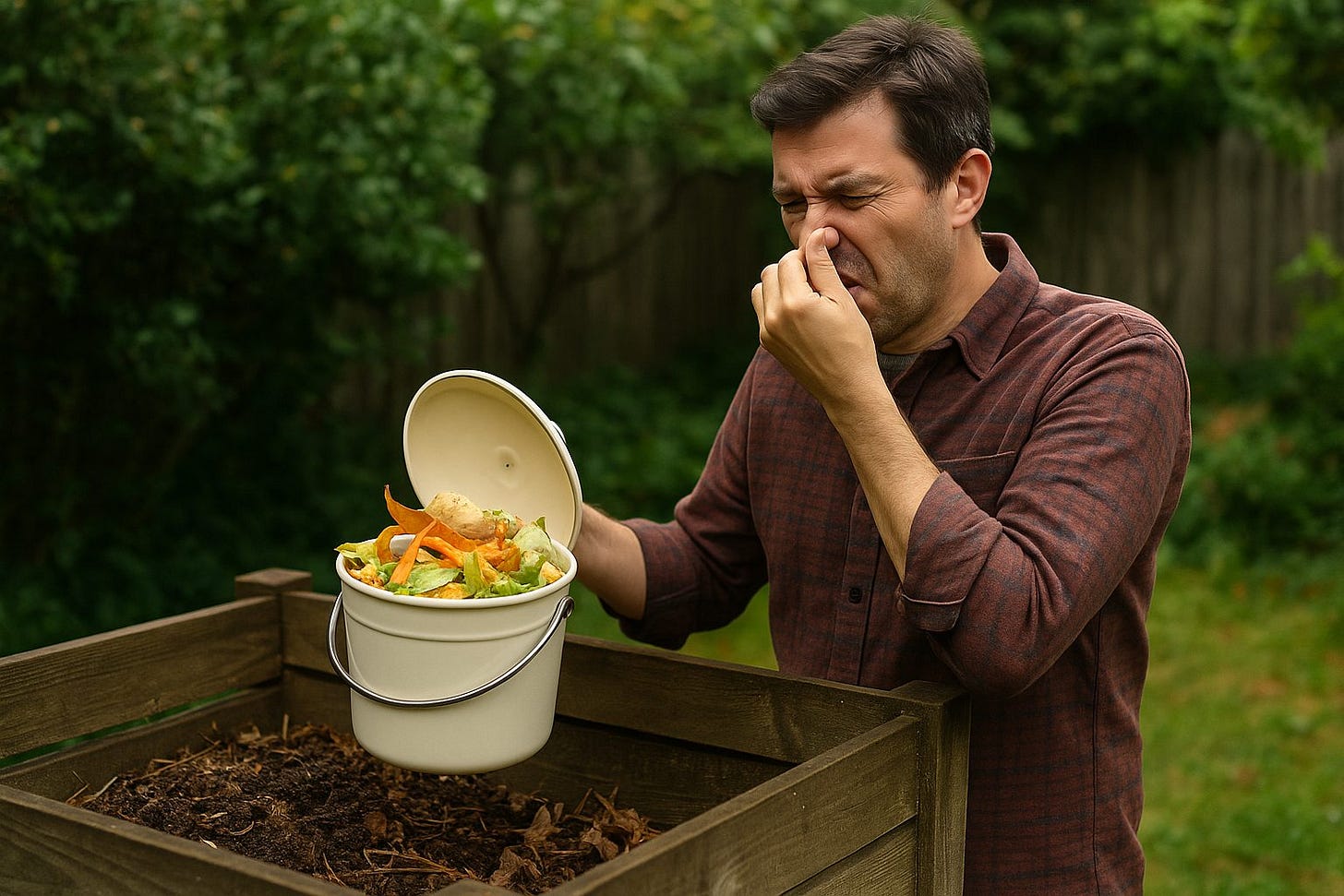9 Composting Hacks for People Who Hate the Smell of Compost
Because “Earthy forest floor” is nice. “Eau de swamp” is not.
If the mere idea of composting makes you wrinkle your nose, you’re not alone. But what if I told you that home composting can smell like fresh soil (yes—really) instead of the bio-hazard zone you imagine? 😏 I’ve curated nine hacks—tried, tested, and practically odour-proof—that turn even the stink-averse into compost champions. Think of this as your smell-proof composting playbook. Ready? Let’s dig in.
1. Balance your greens and browns
Compost smells usually erupt when you have too many “greens” (wet, nitrogen-rich scraps) and too few “browns” (dry, carbon-rich stuff).
According to a recent article, foul odours often point to “an imbalance, lack of circulation, rancid food, and too much moisture.”
So layer in dry leaves, shredded paper, or cardboard every time you dump kitchen scraps. It’s the compost version of salad dressing—wet + dry = harmony.
Also: too much “green” = ammonia smell. Too much “brown” = slow compost. Your goal? A mixture that feels like a damp sponge—moist, but not soggy.
2. Aerate like your pile’s life depends on it (because it does)
Stink happens when your compost goes anaerobic (no air). Those are the microbe parties that smell really bad. The remedy? Turn it, fluff it, let that pile breathe.
One experiment found that strong early aeration helps “move compost out of an odor-generating phase quickly.”
If you have a bin, give it a stir once every few days. If it’s a heap, pitch-fork it. Oxygen = no stink.
3. Control the moisture (and avoid the swamp)
Too wet = bad. Too dry = stop. The sweet spot is damp, not drenched. One site advises treating soggy piles like they’re sick: “Stop adding juicy food waste for a bit… control drainage.”
A practical hack: if your hand comes away dripping after you squeeze a handful, it’s too wet. Add browns. If it feels like a dust pile, mist it lightly.
4. Use filters, liners & clever accessories
If you’re composting inside or near the kitchen, tools matter. Charcoal filters, tight-sealing lids, compostable liners—they all help fight smell at the source.
Here’s a gem: “Use a charcoal filter under the lid… reduces the chance for the bin to attract bugs and lead to any infestation.”
Even lining the bin with newspaper or adding baking soda helps.
5. Cover fresh additions with dry matter
Whenever you add kitchen scraps, drop a layer of leaves, shredded paper, or even sawdust on top. Why? It masks smell, absorbs excess moisture, and keeps flies away.
One “lazy composting” guide says: cover your fresh organic waste with a small layer of soil or brown material to prevent flies and odor.
It’s simple, but surprisingly effective.
6. Avoid the heavy hitters: meat, dairy, oils
Yes—those scraps may seem compost-friendly, but they ramp up the stink factor. Many composting experts say meat and dairy introduce stink-prone waste and attract pests.
If you really want to compost them, use a specialized system (like bokashi), but for regular home composting: keep it veggie-centric.
7. Shrink the size and streamline the feedstock
Large, unmanaged piles become compacted, stinky, and slow. One article says “a huge compost heap can cause problems… it struggles to draw air in.”
Keep your pile manageable. If it’s over 3×3×3 feet (in concept) or simply too big to turn easily, break it down or use multiple bins.
8. Add “mature compost” or odor-absorbing amendments
Here’s a pro move: sprinkle in some finished compost or amendments like biochar to help neutralize smell and boost microbial action. According to Compost Magazine: “Adding 5-10% mature compost … can significantly reduce odors.”
Biochar also helps absorb ammonia and reduce gases. Bonus: it improves your final compost quality.
9. Locate your bin smartly (to set yourself up for success)
Your compost bin’s spot matters. Avoid direct full sun (it can dry things too fast), avoid soggy low spots (water leads to stink). One recent tip list says: “Avoid poorly-draining and windy areas… place bin in partly shaded location.”
In short: choose a well-ventilated, accessible, outdoor spot. Not under your tomatoes. Not in the darkest corner.
Also read: 5 Smart Garden Tools That Help You Grow Food Sustainably
Final thoughts
If you hate the smell of compost but like the idea of cutting waste and producing rich soil—these nine hacks will get you there. Composting doesn’t have to be a stink-fest. It can be clean, efficient, even pleasurable. 🌱
Why not try one hack this week and see how your bin or heap responds? If one trick doesn’t solve it? Layer in another.
Feel free to pick a hack, try it, tell me what happened—and I’ll help you optimize further.


